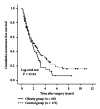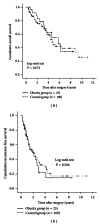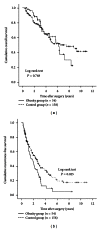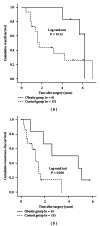The Relation between Obesity and Survival after Surgical Resection of Hepatitis C Virus-Related Hepatocellular Carcinoma
- PMID: 23710167
- PMCID: PMC3655578
- DOI: 10.1155/2013/430438
The Relation between Obesity and Survival after Surgical Resection of Hepatitis C Virus-Related Hepatocellular Carcinoma
Abstract
Background and Aims. We aimed to investigate the relationship between obesity and survival in hepatitis C virus-(HCV-) related hepatocellular carcinoma (HCC) patients who underwent curative surgical resection (SR). Methods. A total of 233 patients with HCV-related HCC who underwent curative SR were included. They included 60 patients (25.8%) with a body mass index (BMI) of > 25 kg/m(2) (obesity group) and 173 patients with a BMI of < 25 kg/m(2) (control group). Overall survival (OS) and recurrence-free survival (RFS) rates were compared. Results. The median follow-up periods were 3.6 years in the obesity group and 3.1 years in the control group. The 1-, 3-, and 5-year cumulative OS rates were 98.3%, 81.0%, and 63.9% in the obesity group and 90.0%, 70.5%, and 50.3% in the control group (P = 0.818). The corresponding RFS rates were 70.1%, 27.0%, and 12.0% in the obesity group and 70.1%, 39.0%, and 21.7% in the control group (P = 0.124). There were no significant differences between the obesity group and the control group in terms of blood loss during surgery (P = 0.899) and surgery-related serious adverse events (P = 0.813). Conclusions. Obesity itself did not affect survival in patients with HCV-related HCC after curative SR.
Figures








Similar articles
-
Lack of correlation between the antibody to hepatitis B core antigen and survival after surgical resection for hepatitis C virus-related hepatocellular carcinoma.Oncol Rep. 2013 Jul;30(1):91-8. doi: 10.3892/or.2013.2422. Epub 2013 Apr 24. Oncol Rep. 2013. PMID: 23615658
-
Effect of body mass index on survival after curative therapy for non-B non-C hepatocellular carcinoma.J Gastrointestin Liver Dis. 2013 Jun;22(2):173-81. J Gastrointestin Liver Dis. 2013. PMID: 23799216
-
Comparison of clinical characteristics and survival after surgery in patients with non-B and non-C hepatocellular carcinoma and hepatitis virus-related hepatocellular carcinoma.J Cancer. 2013 Jul 18;4(6):502-13. doi: 10.7150/jca.6503. Print 2013. J Cancer. 2013. PMID: 23901350 Free PMC article.
-
Surgical Resection of a Recurrent Hepatocellular Carcinoma with Portal Vein Thrombosis: Is It a Good Treatment Option? A Case Report and Systematic Review of the Literature.J Clin Med. 2022 Sep 7;11(18):5287. doi: 10.3390/jcm11185287. J Clin Med. 2022. PMID: 36142934 Free PMC article. Review.
-
The effects of several postoperative adjuvant therapies for hepatocellular carcinoma patients with microvascular invasion after curative resection: a systematic review and meta-analysis.Cancer Cell Int. 2021 Feb 6;21(1):92. doi: 10.1186/s12935-021-01790-6. Cancer Cell Int. 2021. PMID: 33549093 Free PMC article. Review.
Cited by
-
Impact of overweightness and critical weight loss on overall survival in patients with hepatocellular carcinoma initially treated with chemoembolization.Gastroenterol Rep (Oxf). 2019 Aug 28;8(2):125-133. doi: 10.1093/gastro/goz040. eCollection 2020 Apr. Gastroenterol Rep (Oxf). 2019. PMID: 32280472 Free PMC article.
-
Development and validation of nomogram to predict overall survival and disease-free survival after surgical resection in elderly patients with hepatocellular carcinoma.Front Oncol. 2024 May 24;14:1395740. doi: 10.3389/fonc.2024.1395740. eCollection 2024. Front Oncol. 2024. PMID: 38854717 Free PMC article.
-
Predictive factors in patients with hepatocellular carcinoma receiving sorafenib therapy using time-dependent receiver operating characteristic analysis.J Cancer. 2017 Feb 10;8(3):378-387. doi: 10.7150/jca.16786. eCollection 2017. J Cancer. 2017. PMID: 28261338 Free PMC article.
-
Body mass index and cholesterol level predict surgical outcome in patients with hepatocellular carcinoma in Taiwan - a cohort study.Oncotarget. 2016 Apr 19;7(16):22948-59. doi: 10.18632/oncotarget.8312. Oncotarget. 2016. PMID: 27027345 Free PMC article.
-
Sex Differences in the Impact of Metabolic Dysfunction-associated Fatty Liver Disease on the of Patients with Hepatocellular Carcinoma After Radical Resection.J Cancer. 2023 Apr 17;14(7):1107-1116. doi: 10.7150/jca.83779. eCollection 2023. J Cancer. 2023. PMID: 37215444 Free PMC article.
References
-
- Livraghi T, Mäkisalo H, Line PD. Treatment options in hepatocellular carcinoma today. Scandinavian Journal of Surgery. 2011;100(1):22–29. - PubMed
-
- de Lope CR, Tremosini S, Forner A, Reig M, Bruix J. Management of HCC. Journal of Hepatology. 2012;56(supplement 1):S75–S87. - PubMed
-
- El-Serag HB. Hepatocellular carcinoma. The New England Journal of Medicine. 2011;365:118–1127. - PubMed
-
- Umemura T, Ichijo T, Yoshizawa K, Tanaka E, Kiyosawa K. Epidemiology of hepatocellular carcinoma in Japan. Journal of Gastroenterology. 2009;44(19, supplement):102–107. - PubMed
LinkOut - more resources
Full Text Sources
Other Literature Sources
Research Materials

